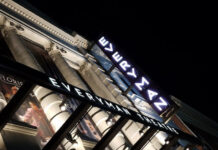DC Theater Arts was excited to speak to Charm City Fringe Festival founders Zach Michel and Michael Brush last week at the Lexington Market. We enjoyed a nice chat over crab cakes and local beer. Here are some of the highlights from our conversations…

This is clearly a labor of love, not just for the two of you, but for everyone on staff at Charm City Fringe (CCF). This will be your sixth year. What keeps you guys returning to Fringe year after year?
Michael Brush: Threatening voice-mails from Zach, mostly.
Zachary Michel: Mike and I are both really persistent.
Michael: I think everyone on staff has different motivations, but I can say that for myself, I’ve fallen in love with the fringe. The atmosphere of the events, the excitement of seeing new artists staging their creations and putting themselves out there.
Zach: We have this vision of elevating and celebrating theater across Baltimore on a statewide level. We want to see a vibrant theater scene, with multiple levels in which patrons and artists can engage. We’ve made progress each year, but we haven’t gotten there yet. Seeing artists graduate from CCF to go perform on the national stage or otherwise become successful working artists is tremendously rewarding.
Michael: There’s something very valuable in what we do, and I plan to see it through until I don’t find those things as exciting as I did in 2012 when it was just me and Zach dangerously hanging lights at the former Autograph Playhouse.

Is there a difference between the DC Fringe scene and the Baltimore one? Or is Fringe something that unites all across the country?
Zach: A little bit of both.
Michael: I think, much like music, every city offers something a little bit different when it comes to the scene.
Zach: DC’s theater scene, on the whole, is far larger and more comprehensive than Baltimore’s at this time.
Michael: Baltimore is notorious for being a DIY community, and I think that shines through in the festival year after year from the local companies that participate. There are the fringe ol’ timers and circuit-travelers that bring a sense of unity to the country’s, and the world’s, Fringes though. It’s a part of what makes Fringe Festivals so appealing to so many people. There’s an opportunity to see so many different types of work, and truly dive into the community.
Zach: While both Fringes function as an affordable way for artists to produce new work, Cap Fringe seems to serve more as a way for artists to break into the competitive industry of the city, whereas Charm City Fringe serves more to help develop and cultivate new artists to achieve the same end on the overall theater community (development and growth). Fringe worldwide, however, works towards similar ends, and each Fringe tends to reflect the needs and culture of its city.

Organizing artists is…can they be organized?
Michael: Ah, I see you’ve attempted to organize artists previously.
I mean, Science says no, right?
Zach: You are very perceptive.
But, part of what you have to do is organize a bunch of creative people and ensure that the event goes off with the minimum-est of hitches. What have been some of your biggest lessons learned? What were the best mistakes?
Michael: Essentially, the most important thing to keep in mind is that our job is to allow the artists to do what they do best; create art.
Zach: Communication is key, as with all relationships, I suppose.
Michael: Overall, it’s a test of patience, perseverance, and the right balance between nurturing and nagging. We’re going to handle the box office, ticketing service, scheduling logistics, program creation, and all of the no-fun logistics (unless you’re a logistics-lover like myself, in which case you get slightly aroused when thinking about how you can create a new spreadsheet that will keep track of everyone’s materials while simultaneously emailing the artists that haven’t given you the shit you’ve been asking for, for weeks).
Zach: We’ve found out just how easy it is for misunderstandings to arise and for information to be missed.
Michael: We’ve made more mistakes than I can count, and we’re not afraid to admit them when we make them, sometimes to a fault. I think the best mistake we’ve ever made was putting one of our festival venues inside of an art gallery that was hosting an erotic art show. It was, at first, terrifying to think that families would be attending a CCF venue where a giant ride-able wooden penis took up approximately 20 square feet of the space. However, by the end of the festival, very few people had anything negative to say, and, we got to ride a giant wooden penis.

Yeah you did.
Zach: I really can’t think of any huge mistakes or happy accidents. I will say, I reached out to a reporter (Jacques Kelly) a little over a year ago to pick his brain about the arts and he ended up doing a piece on us and our thoughts on producing in the Bromo Arts District. That was before we had actually given a move to the district any thought, but it got the wheels turning, caused some outsiders to take notice, and a year later, here we are.
Fringe shows offer newer voices in the arts a chance to get some stage exposure. What can attendees expect this year from the acts you’ve lined up?
Michael: Expect something different every time you walk into a venue. No two shows are alike this year. Whether it’s a perverted clown, synchronized roller skating, or modern dance, it’s all fringe, and it’s all going to be fun.
Zach: We’ve got so much great art lined up.
Michael: A word of warning: part of the fun of fringe is not knowing what you’re going to get. It could be great, or it could be awful. There’s no telling until you’ve gone and done it and I promise it’ll be worth it either way.
Zach: Attendees should look to push themselves towards new experiences, and we have 25 different opportunities to do that. Because we moved to Bromo, venue-hopping is a great way to experience the festival — see a show, hop next door for another, grab a drink at our HQ at Le Mondo, and then see a third as a nightcap. We’ve made the grounds more fun and engaging overall, adding buskers on weekends! Guests can take the light rail down and never have to worry about street parking, or park once, because regardless, each venue is within a two block radius.

What are the components of a Perfect Fringe Show? Would you suggest that Fringe shows are rough drafts of larger shows? Or are they unique animals unto themselves?
Michael: This varies from artist to artist, patron to patron, and Fringe to Fringe. For me, the perfect fringe show is one that I find myself fully engaged in, not thinking about the 30 emails I’ve received about the latest (typically figurative) fires that need to be put out across the festival.
Zach: The “Perfect Fringe Show” looks for new ways to tell a story and present it to the audience. It takes risks and is unencumbered by the thought of failure. And they market the crap out of it – a packed house has that electric feel to it and makes everything more fun.
Michael: It’s a show that, at the end, I can’t stop smiling because of the enjoyable time I had there. Or, perhaps, a show that lights a fire under me, making me feel and believe that our world isn’t as terrible as the news portrays it, that there are beautiful things happening, and I had the honor and privilege of being a part of it.
Zach: That’s all up to the artist. We’ve seen it both as a finished product and as a way to workshop and explore the boundaries of theater.
“As long as _______________________ doesn’t happen, we can call this a success!” What would you fill that blank with?
Michael: As long as Donald Trump doesn’t get elected president in the middle of our festival again, we can call this a success.
Be serious, Michael.
Michael: As long as the artists performing and the patrons attending leave the festival feeling something (good or bad!), we’ve been successful. Art should push boundaries and make you think. I want people involved in CCF, whether they be a first-time theater-goer or seasoned veteran of the Fringe circuit, to leave thinking and starting a dialogue about what they have seen.
Zach: I’ll turn this around, to “as long as ______ DOES happen, I’ll call it a success.” That would be: happy audiences and artists. We do this for them, so to have them come away with a positive experience means everything. Mind you, that doesn’t mean every show goes off without a hitch, but as long as the artist is in a place where they can learn and grow from it, we’re in a good place.
What show(s) are each of you looking forward to this year?
Michael: Yes.
Zach: I think there’s a lot of overlap between what we’re excited about. Me personally, I’m looking forward to Fluid Movement’s A Chiller Thriller Roller Show, Heather Massie – HEDY! The Life & Inventions of Hedy Lamarr, and QuaQuaQua – Godly Chaos.
Baltimore’s historic Lexington Market is joining DC Theater Arts in support of our coverage of the Charm City Fringe Festival. The Market closes at 6 PM on weekdays and is closed Sundays, but we recommend that Fringe-goers stop by on Saturday to grab lunch and take a look around, in addition to checking out the local bands which play from 12:00 PM to 2:00 PM.





